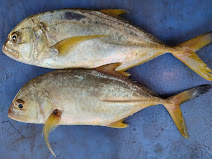A fish thats oily, strong flavored , rich source of omega-3 fatty acids, has Selenium which is great for your cardiovascular health - Indian MACKEREL is one of the tastiest and cheapest fish that you can find plentiful. Indian Mackerel is recognized as the national fish of India. Also called Long jawed mackerel, Striped Mackerel. Indian mackerel is distributed along coastal waters of the Indian Ocean and West Pacific
Scientific name : Rastrelliger Kanagurta
Size : 25cm(common) 35cm(Max)
Mackerel spoils quickly unless properly refrigerated. Its best eaten when fresh, which tastes real good. An important fish that is consumed worldwide but can lead to food poisoning , if it gets spoilt. Mainly used fresh but they are available as frozen, canned, dried salted and made into fish sauces.
Scientific name : Rastrelliger Kanagurta
Size : 25cm(common) 35cm(Max)
Mackerel spoils quickly unless properly refrigerated. Its best eaten when fresh, which tastes real good. An important fish that is consumed worldwide but can lead to food poisoning , if it gets spoilt. Mainly used fresh but they are available as frozen, canned, dried salted and made into fish sauces.
Benefits of Indian Mackerel & Why YOU should consume it regularly
When it is Harmful
Click here 👆👆👆 for list of 100 popular fishes with Images .
Common Names for Indian Mackerel :
Malayalam: Ayala, Aila, Ayila
Tamil: Ayilai , Kumla , Kannankeluthi, kanangeluthi, Kana Kayuthai, kanaam, keluthi aila,Kumla, Augalai, Ailai, Kanangeluthi
Kannada: Bangde,Banguda, Telbangade
Telugu: Kannangadatha,kanagarthalu
Gujarathi: Bangada , Malbari bhangda
Hindi :Bangadi
Marathi:Bangada
Oriya: Kangurta , Karan kita, Marua
Bengali: Khap khopi , Lajjabatti sating
Others Indian Names: Bangda, Bangdo (konkani), Bangade,बांगडो, ಬಾಂಗ್ಡೊ
Arabic: Basha, garfa,bagha, Khadhra, Karuga
Tagalog: Alumahan (long jaw) Hasa Hasa (short Bodied), Kabalyas, Bulau
Srmai,surmaya, bangra(Pakistan)
Sinhalese : Ailai,Karung kuluttan, Kumbala, Maha kara bolla
Malay : Kembung borek, Mabong, Pelaling
Hokkein : Maa Boong
Cantonese Maa Bonk
Indonesia : Pelaling
Afrikaans :Langkaak-makriel, Indiese makriel
Burmese : Nga-atpon, Nga-gongree
French : Maquereau des Indes, Makro dou
Japanese : Gurukuma, Saba
Portuguese : Cavala, Cavala-do-Indico
Spanish : Caballa de la India
Thai : Pla lung, Pla thu mong
- Low in mercury level (Less than 0.09 ppm)
- It enchances eyesight. It prevents the damage done to the eyes because of diabetes
- Its rich in Omega 3 (2626mg) and protein thus a lower risk of getting affected by depression
- Contains Selenium which is great for your cardiovascular health
- It lowers blood pressure and reduces Cholestrol
- Planning to lose weight, go for it.
- Lowers risk of diabetes as it also lowers visceral fat
- Rich in monounsaturated fatty acids and polyunsaturated fatty acids
- Low in saturated fats
- Prevents arthritis as it contains anti-inflammatory compounds
- Its one of the very few natural sources containing vitamin D
- It takes care of all your skin and hair care needs with sufficient amount of antioxidant properties, Omega 3 and Selenium.
- There are many minerals in Mackerel thus improving Bone Mineral Density
When it is Harmful
- It's a bony fish, with lots of tiny fine bones between the flesh. If you don't know how to eat such fishes , better avoid them.
- When you are allergic to seafood .
- Kidneys and liver disease patients should not eat the oily mackerel, it may aggravate.
- You are suffering with the gastrointestinal tract, then best to avoid salty and fried fish.
- When there is excess amounts of selenium in the body, avoid it
Click here 👆👆👆 for list of 100 popular fishes with Images .
| Nutrient | Value |
|---|---|
| Mercury level | 0.09 ppm (Low) |
| Omega 3 | 2646 mg |
| Omega 6 | 219 mg |
| Protein | 18.6 mg |
| Vitamin D | 643IU |
| Calcium | 12 mg |
| Sodium | 90mg |
| Calories | 205 |
| Cholestrol | 75 mg |
| Vitamin B12 | 8.7 mg |
| Vitamin C | 12 mg |
Common Names for Indian Mackerel :
Malayalam: Ayala, Aila, Ayila
Tamil: Ayilai , Kumla , Kannankeluthi, kanangeluthi, Kana Kayuthai, kanaam, keluthi aila,Kumla, Augalai, Ailai, Kanangeluthi
Kannada: Bangde,Banguda, Telbangade
Telugu: Kannangadatha,kanagarthalu
Gujarathi: Bangada , Malbari bhangda
Hindi :Bangadi
Marathi:Bangada
Oriya: Kangurta , Karan kita, Marua
Bengali: Khap khopi , Lajjabatti sating
Others Indian Names: Bangda, Bangdo (konkani), Bangade,बांगडो, ಬಾಂಗ್ಡೊ
Arabic: Basha, garfa,bagha, Khadhra, Karuga
Tagalog: Alumahan (long jaw) Hasa Hasa (short Bodied), Kabalyas, Bulau
Srmai,surmaya, bangra(Pakistan)
Sinhalese : Ailai,Karung kuluttan, Kumbala, Maha kara bolla
Malay : Kembung borek, Mabong, Pelaling
Hokkein : Maa Boong
Cantonese Maa Bonk
Indonesia : Pelaling
Afrikaans :Langkaak-makriel, Indiese makriel
Burmese : Nga-atpon, Nga-gongree
French : Maquereau des Indes, Makro dou
Japanese : Gurukuma, Saba
Portuguese : Cavala, Cavala-do-Indico
Spanish : Caballa de la India
Thai : Pla lung, Pla thu mong






 Did you Know : The National fish of India is Indian Mackerel and why you should eat it
Did you Know : The National fish of India is Indian Mackerel and why you should eat it









0 comments:
Post a Comment